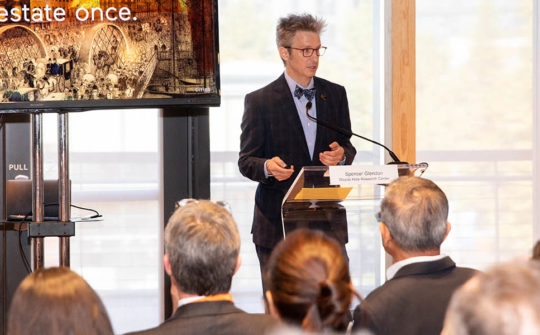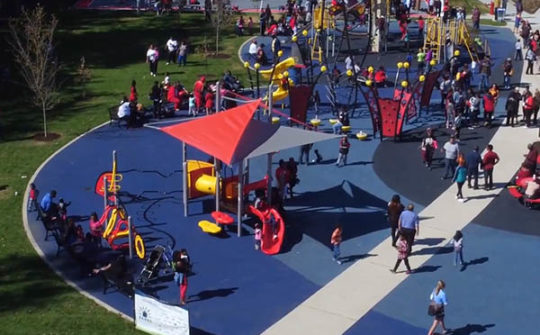In fiscal year 2020, the ULI Greenprint Center for Building Performance celebrated its 10th anniversary of reducing carbon emissions while building asset value. Since 2009, Greenprint members have showcased their leadership through measurement, benchmarking, knowledge sharing, and the implementation of best practices.
Volume 10 of the Greenprint Performance Report, released in FY20, analyzed the performance of almost 9,000 properties, increasing the number of properties by 12 percent from the past year and 15 percent in terms of floor area to over 2 billion square feet (over 190 million sq m) across 32 countries. Over the year, Greenprint made significant progress toward its goal, demonstrating a 10-year improvement of 17 percent in energy use and keeping the portfolio on track to achieve its goal of reducing greenhouse gas emissions by 50 percent by 2030.
To continue driving the market forward toward high-performance green buildings, Greenprint published multiple new resources in FY20. While these reports focus on specific building types and trending sustainability topics, each showcases best practices identified through research and interviews from Greenprint leaders and experts in the broader market.
Sustainability in Hotels: Opportunities and Trends Shaping the Future of Hospitality assessed the state of sustainability in the hotel sector; identified best practices in energy efficiency, water conservation, and waste reduction; and highlighted industry trends to watch. Hotels are among the highest per square foot energy and water users of all commercial buildings, but hotels pay utilities directly and can directly recoup all savings from efficiency improvements, resulting in one of the strongest business cases for sustainability.
Going beyond traditional operational carbon emissions, Greenprint also published Embodied Carbon in Building Materials in Real Estate. Embodied carbon, which refers to the emissions associated with manufacturing, transportation, and construction of building materials, as well as building disposal, accounts for 11 percent of global greenhouse gas emissions. Without addressing embodied carbon, real estate will not be able to achieve ambitious climate goals. Greenprint’s report showed how easy it is for developers to begin taking the necessary steps.
Greenprint also partnered with the Rocky Mountain Institute and the Building Owners and Managers Association to conduct research on the challenges and opportunities to achieve energy efficiency across class B and C office portfolios. Unlocking Hidden Value in Class B/C Commercial Buildings: Best Practices for Pursuing Low-Cost, High-Impact Energy Efficiency and Green Leasing Strategies shows how improving the energy efficiency of class B and C office buildings is doable with relatively simple, lower-cost measures that enhance building performance and make the buildings more competitive.

Greenprint expanded its city engagement program with a City and Real Estate Summit in Washington, D.C., and distilled recommendations from this workshop and past ones into Decarbonizing the Built Environment: 10 Principles for Climate Mitigation Policies. The principles described in this report aim to accelerate progress toward shared climate action goals, providing useful tools and policy success to help city officials and those in the real estate industry engage with each other in a meaningful and ongoing way.
Greenprint’s Tenant Energy Optimization Program also released a new program case study in fiscal year 2020, highlighting the Rocky Mountain Institute’s space at Boulder Commons, a hyper-energy-efficient and sustainable multitenant net-zero-energy (NZE) office building. This project was cost-effective for both the developer and the tenants, and it can serve as a model for the next level of high-performing, sustainable tenant spaces.
In partnership with other departments, Greenprint integrated its content and expertise into ULI’s signature programs. Greenprint supported two Advisory Services panels in fiscal year 2020. One in Washington, D.C., provided strategic recommendations on how DowntownDC BID building owners can cost-effectively meet D.C.’s sustainability goals and the second in Toronto determined how the public and private sectors can work together to drive sustainable retrofits of Toronto’s tower housing while maintaining affordability.
In fiscal year 2020, Greenprint also contributed content and speakers to 12 in-person and virtual district council events on topics including tenant space efficiency, hotel sustainability, and embodied carbon.
Together, Greenprint’s body of work adds to the Institute’s ongoing efforts to build the business case for sustainable development and climate mitigation. Find Greenprint reports in Knowledge Finder.
Find sustainability and energy efficiency experts in the Member Directory.
ULI Members who wish to learn more about becoming an Innovation Partner or Member Company may submit an inquiry on Navigator. They may also find Greenprint reports on Knowledge Finder and sustainability and energy efficiency experts in the Member Directory.
Give to the Annual Fund and the ULI Foundation to support ULI’s research on sustainable development.


